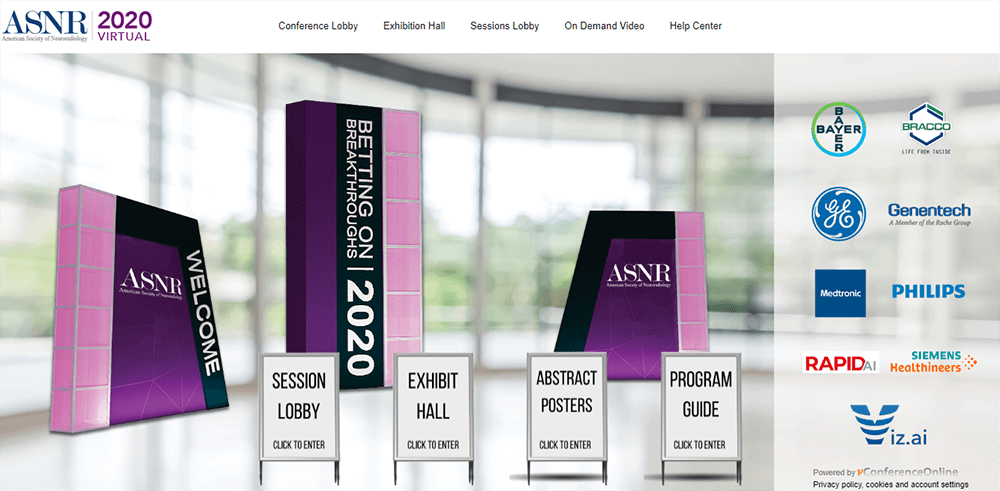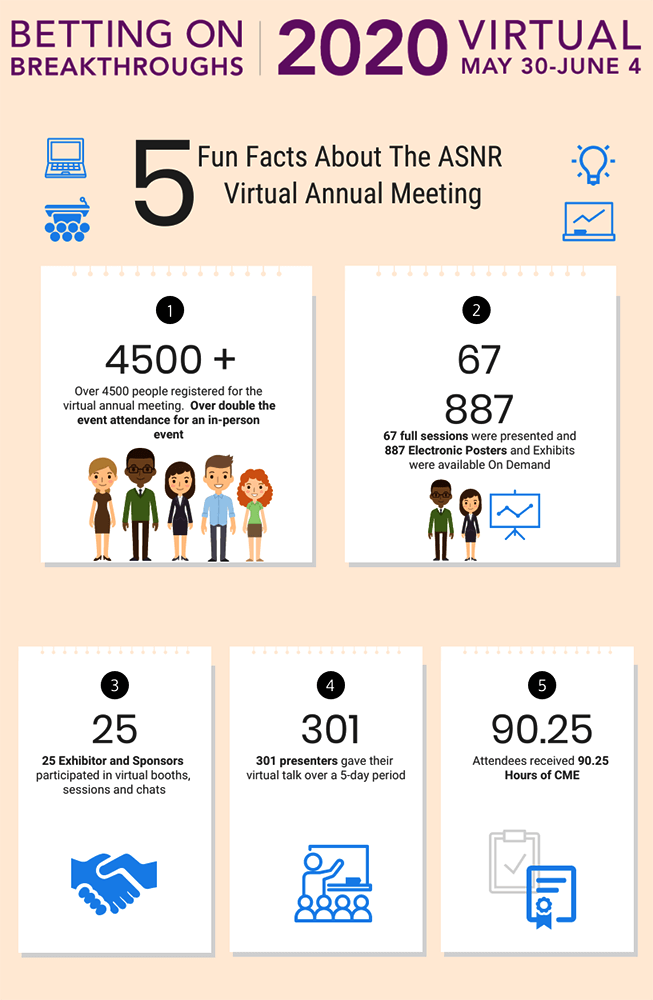
The COVID-19 pandemic forced the the American Society of Neuroradiology to recreate its already reimagined 2020 Annual Meeting as a digital event.
The American Society of Neuroradiology’s (ASNR) 2020 Annual Meeting, May 30–June 4 — themed “Betting on Breakthroughs” as a nod to host destination Las Vegas — was on track to be one of the most successful events in the society’s long history. Working with ASNR Executive Director Mary Beth Hepp, Director of Education Erica Kruse, Meetings Director Lynn Brown, and with the full support of ASNR’s board, “the way we planned, organized, and marketed the meeting and symposium” was being completely rethought, said program chair Joshua Hirsch, M.D., FACR, FSIR, FSNIS. They added new tracks, deepened the scope of the event, created multiple new partner opportunities, and worked hard to get the schedule and abstract topics out earlier to members, non-members, and vendors, both nationally and internationally, he said, adding, “We held nothing back.”
As a result, “the response by industry sponsors was fantastic,” Hepp said. With vendors participating from all over the world and in all aspects of neuroradiology — software, hardware, AI, interventional, and more — #ASNR20 was set “to be the highest sponsor-based revenue-producing meeting in the society’s history by a remarkably wide margin,”she said. Early registrations indicated attendance levels would also set a new record, attracting more than 2,000 participants.
But in February, the picture began to look less rosy. “When COVID-19 first showed up in Wuhan, China, we realized participants from that region weren’t going to be able to make the trip in numbers,” Hirsch said. “Then the virus hit Europe, and it became obvious that European involvement was not going to be at the levels we had anticipated. Despite these realities, we still hoped that #ASNR20 could still be a live meeting. By March, however, it became apparent that the world had changed and an in-person meeting in Vegas was going to be, at the very least, challenging.”
Putting the conference on pause and starting over again in 2021 was not an option. “We had put so much energy into creating the Vegas meeting that it was hard to walk away from it,” Hirsch said. “As the biggest booster on the volunteer side, I felt like I had to be the first one to say the words out loud: ‘We need to once again reimagine #ASNR20 and go virtual.’”
Moving the event online required intense teamwork and support across the board, Hirsch said, with everyone figuring out the various logistics involved, including contract legalities, policies, technology, marketing, training, all while maintaining good relationships.
Moreover, the process also required tremendous flexibility. “When you take a crash course in doing something new, you don’t have an FAQ to follow,” Hirsch said. “We — staff, vendors, and speakers — were all figuring out things together in this new world. We had to have patience and work to find mutually workable solutions.”
Here’s how ASNR made the transition to virtual.
Renegotiating Contracts, Keeping Relationships Intact
 “Our first step was to call Caesars Palace to figure out how to move forward in a way that didn’t penalize the society or the hotel,” Hirsch said. “Thanks to the good relationship that Lynn had developed with her contact at Caesars, she was able to renegotiate the details of the contract in a way that all parties were satisfied and with full support of our board.”
“Our first step was to call Caesars Palace to figure out how to move forward in a way that didn’t penalize the society or the hotel,” Hirsch said. “Thanks to the good relationship that Lynn had developed with her contact at Caesars, she was able to renegotiate the details of the contract in a way that all parties were satisfied and with full support of our board.”
“I think that dealing one-on-one with our contact and having calm conversations on how we are all in this together helped us find a win-win,” Brown said, “for both the hotel and for the society.”
‘Good Will’ Policies
ASNR’s board agreed from the onset that the society would use the “good will” principle. Anyone who requested a refund — registrants or vendors — would be given 100 percent of their money back. Registrants were offered several options, including the ability to roll over their fee for next year’s live meeting. Vendors were offered a free virtual booth at #ASNR20 if they applied their current fees to an in-person booth next year. If a vendor wanted a refund, they could buy a virtual booth this year for $1,000.
An Early Start on Technology
ASNR had been thinking about adding virtual components to its offerings for awhile. “You could have wanted to do a virtual meeting 10 years ago but the tools weren’t there,” Hirsch said. “The sledgehammer of a global pandemic has helped us to overcome technological trepidations to open up other opportunities.”
Shifting the meeting from in-person to virtual meant finding the right technological engine to host the event. Kruse began searching for an online platform immediately. “I think our ability to maneuver so quickly was the fact that Erica jumped in and set up appointments with several different companies to try out their platforms before it became obvious that we were headed in this direction,” Hepp said. “We wanted to have all of our options vetted and ready to go once we made a decision. This legwork put us ahead of other associations who were also moving to a virtual meeting as we were able to be put on the build schedule for platforms before the companies were all booked up.” The organization streamlined the amount of content and turned the abstracts into eposters – increasing the number from 400 entries to 1,000.
A Creative Marketing Campaign
“Our next step was to get the word out to all meeting stakeholders,” Kruse said. “We already had a communication system in place for all of our COVID-19 messaging. We used vehicles such as email, Twitter, Facebook, and our website to educate registrants, speakers, vendors, and the like on moving virtual. We sought creative partnerships with other societies in the radiology and neuroradiology space.” Thanks to these efforts, ASNR wound up increasing registration — particularly among international registrants — to more than 4,400, of which 45 percent were non-members. The hashtag, #ASNR20, went viral with more than 15 million impressions.
The Right Price Point
The virtual event was under $200, approximately 10 to 20 percent of the cost (depending on membership type) of the in-person meeting.
A Mix of Formats
The program’s plentiful content was organized and presented in a way that wasn’t overwhelming. Oral abstract presentations and posters (representing about half of the content) were treated as more of a virtual library. They didn’t have a live air time and date — participants could view them on demand through a searchable interface.
All of the presentations were pre-recorded, with about half of them airing on the same dates and at the same time as the original event schedule and featuring a live Q&A with the presenters.
Hepp said that one of the most important aspects of the virtual event is the “after market.” Available now on download, participants can view the content that was most important to them for 90 days post-event. In addition, individuals who were not able to attend can purchase access to the download. “We found that one-third of participants joined us in real time,” Hepp said, “one-third will be watching on demand, and the last third pursued a [mix] of IRL and on-demand.”
Beneficial Sponsor Realignment
“You have to reset your expectations on what is appropriate for a sponsorship” when you move to a digital platform, Hepp said, because what works in a face-to-face event — like distributing a Wi-Fi password — doesn’t always translate. Event organizers should leverage benefits of the virtual environment. For example, two sponsors of clinical update sessions at the physical event were moved to virtual clinical update sessions, and a virtual focus group was added to their package.
Investing in Training
Recording lectures is not as easy as getting on a Zoom chat. In order to have the virtual meeting be a success, a great deal of time and training went into helping speakers handle the technology needed to give their presentation. This included recording the speech, uploading it onto the platform, using slides to enhance the lecture, and being able to handle questions and answers during the session. By taking this proactive approach, ASNR was able to retain 95 percent of the original event’s speakers.
Hirsch, Hepp, Brown, and Kruse all agree that they successfully transitioned their event to a virtual meeting by embracing uncertainty. In the process, the organization has been fundamentally changed. “While this virtual adventure came about for unfortunate reasons,” said Hirsch, who is now serving as ASNR’s president, “distance learning is something ASNR will embrace and lead the industry in.”
Michelle Russell is Convene’s editor in chief.
